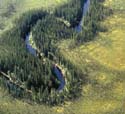
River in Alaska bordered by P. glauca forests surrounded by muskeg containing scattered small P. mariana [Dr. Linda B. Brubaker].
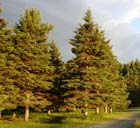
Trees about 10 m tall in Baxter State Park, Maine [C.J. Earle, 2003.07].
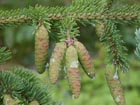
Immature cones on a tree by Browns Point Light, Vinalhaven Island, Maine [C.J. Earle, 2003.07].
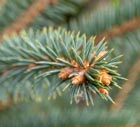
Foliage and buds on a tree at Buffalo River State Park, Minnesota, elev. 990 ft [C.J. Earle, 2019.09.28].
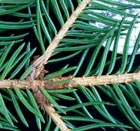
Detail of twig and foliage on a tree in Peninsula State Park, Wisconsin. Coin is 24 mm diameter [C.J. Earle, 2019.10.07].
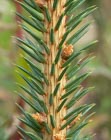
Foliage and buds on a growing leader at Buffalo River State Park, Minnesota, elev. 990 ft [C.J. Earle, 2019.09.28].
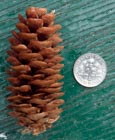
Mature cone, fully opened, from a tree near Haines Junction, Yukon [C.J. Earle, 2011.07.05].
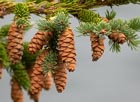
Ripe cones crowding the crown of a tree on the shore of Lake Superior, Michigan [C.J. Earle, 2019.10.04].
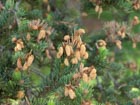
Foliage and pollen cones at Buckinghorse River, Yukon [C.J. Earle, 2011.06.26].
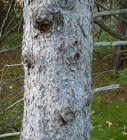
Bark of a tree about 30 cm diameter; Peninsula State Park, Wisconsin [C.J. Earle, 2019.10.06].
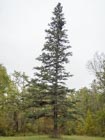
Large mature tree, about 80 cm dbh and 25 m tall, forest-grown but now in a clearing at Itasca State Park, Minnesota [C.J. Earle, 2019.10.04].
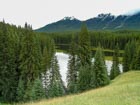
Picea glauca dominates the forest at Pilot Pond, Banff National Park, Alberta [C.J. Earle, 2004.09.03].

A riparian forest in Itasca State Park, Minnesota is dominated by Picea glauca and Abies balsamea; emergent Pinus strobus are prominent in the upland hardwood forest [C.J. Earle, 2019.09.29].

Spruce waves on The Brothers, seen from Mt. Katahdin, Maine [C.J. Earle, 2003.07].

Detail view of a spruce wave on The Owl, seen from Mt. Katahdin, Maine [C.J. Earle, 2003.07].

Picea glauca
(Moench) Voss 1907
Common names
White spruce, Canada spruce, skunk spruce, cat spruce, single spruce; western white spruce (var. albertiana; Canadian Rocky Mts); Porsild spruce (var. porsildii); Black Hills spruce (var. densata, Dakota); épinette blanche [Canadian French]; gaawaandag, mina'ig [Ojibwe].
Taxonomic notes
Synonymy:
- Pinus glauca Moench 1785;
- P. albertiana S. Br. subsp. ogilviei W. L. Strong & Hills 2006.
Two varieties have been described:
- P. glauca (Moench) Voss var. densata L. H. Bailey 1933 (syn. P. albertiana S. Br. var. densata (L. H. Bailey) W. L. Strong & Hills 2006), and
- P. glauca (Moench) Voss var. porsildii Raup 1947 (syn. P. albertiana S. Br. var. porsildii (Raup) W. L. Strong & Hills 2006).
Variety densata is limited in distribution to the Black Hills of South Dakota and some nearby areas (the type is from North Dakota) and is distinguished by a more dense growth form. Farjon (1990) dismisses it as "merely an ecotype" but it does have a distinct growth form and retains that character when planted elsewhere, evidence that it warrants taxonomic treatment at some rank; as it seems not to have been described as a form, it is here listed as a variety, but may be more accurately described as a cultivar (Missouri Botanical Garden, accessed 2021.06.12). Variety porsildii, the Porsild spruce, presents a more interesting problem. Its primary distinguishing character is smooth bark with resin blisters, a common enough character in Abies but very rare in Picea, otherwise seen only in Picea morrisonicola of Taiwan. Formerly thought limited to Alaska, Savidge (2013, 2014) documents its occurrence at scattered locations throughout the range of P. glauca from Alaska to Nova Scotia and Labrador (but not, so far, in Saskatchewan, Manitoba or Nunavut), and also presents evidence that it is not of hybrid origin, and can result from crosses of specimens of the type variety. This occurrence pattern suggests that it is a true forma, spontaneously arising from the type variety in response to genetic recombination or perhaps in response to an environmental trigger. Again, it has only been described at varietal rank, and is here so named.
Besides the varieties, this very widespread species has some widespread and economically important hybrids:
- The hybrid with Picea engelmannii is Albert spruce, P. × albertiana S. Br. 1907 (syn.: P. albertiana S. Br. 1907; P. glauca (Moench) Voss var. albertiana (S. Br.) Sarg. 1919; P. glauca (Moench) Voss subsp. albertiana P. A. Schmidt 1988).
- The hybrid with P. sitchensis to form Lutz or Roche spruce, P. × lutzii Little.
- Hybrids between all three species occur in the Skeena River area of British Columbia (Sutton et al. 1994).
Description
Trees to 50 m tall and 100 cm dbh (Farjon 1990); "crown broadly conic to spirelike. Bark gray-brown. Branches slightly drooping; twigs not pendent, rather slender, pinkish brown, glabrous. Buds orange-brown, 3-6 mm, apex rounded. Leaves (0.8)1.5-2(2.5) cm, 4-angled in cross section, rigid, blue-green, bearing stomates on all surfaces, apex sharp-pointed." Seed cones green or violet ripening pale buff, cylindric, soft, "2.5-6(8) cm; scales fan-shaped, broadest near rounded apex, 10-16 × 9-13 mm, flexuous, margin at apex ± entire, apex extending 0.5-3 mm beyond seed-wing impression. 2n=24" (Taylor 1993). See the Taxonomic Notes regarding distinguishing characters of the varieties.
P. × albertiana has unusually prominent leaf bases, cones nearly as broad as long, cone scales acute and broader than long, and an unusually narrow crown (Taylor 1993). The shoots are pubescent (rather than glabrous, as in P. glauca) and the leaves slightly longer (1.5-2 cm, vs. 0.8-1.3 cm for P. glauca) (Farjon 1990).
P. × lutzii has slightly quadrangular needles (less so than in P. glauca) with whitish stomatal lines on the upper surfaces (as in P. sitchensis, but not in P. glauca). Seed cones are (3-)4-7 cm long, the seed scales short and rounded, thin, light brown, with an erose-denticulate upper margin (Farjon 2010).
Distribution and Ecology
Canada: Alberta, British Columbia, Manitoba, New Brunswick, Newfoundland, Northwest Territories, Nova Scotia, Nunavut, Ontario, Prince Edward Island, Québec, Saskatchewan, Yukon; France: St. Pierre and Miquelon; USA: Alaska, Maine, Michigan, Minnesota, Montana, New Hampshire, New York, North Dakota, South Dakota, Vermont, Wisconsin, Wyoming. Occurs at elevations of 0-1000 m (Farjon 1990), in habitats ranging from muskegs, bogs, and river banks to montane slopes (Taylor 1993). It is a dominant tree of interior forests over vast expanses of Canada and Alaska. Hardy to Zone 2 (cold hardiness limit between -45.6°C and -40.0°C) (Bannister and Neuner 2001).
Distribution data from USGS (1999).
P. × albertiana occurs primarily in Canada: British Columbia (widespread) and southwest Alberta, with a few collections in far southern Yukon; and in USA: western Montana, Idaho, and northeastern Washington, with a few collections in far northwestern Wyoming and interior southeastern Alaska (2020 review of data from the Consortium of Pacific Northwest Herbaria).
P. × lutzii occurs wherever the ranges of P. sitchensis and P. glauca overlap, such as along major river corridors across the British Columbia Coast Range and in coastal Alaska. Analysis of this introgression zone indicates that the region was first colonized by P. sitchensis during late Pleistocene deglaciation, with subsequent introgression when P. glauca arrived via dispersal from Alaskan or eastern Canadian refugia (Hamilton and Aitken 2013). Moreover, hybrids between these two species and P. engelmannii occur in the Skeena River area of British Columbia (Sutton et al. 1994).
The top photograph at right illustrates characteristic habitat partitioning between P. glauca and P. mariana. The two species co-occur over a wide range and have evolved a very complex competitive relationship involving contrasts in tolerance of mesic sites, capacity to reproduce vegetatively, timing of reproductive phenology, rate of seedling and sapling growth, and some other factors. In general, though, P. glauca enjoys a competitive advantage on well-drained mineral soils with deep or no permafrost, such as the alluvial levees along the stream in the photograph, while P. mariana is more tolerant of adverse site conditions including flooding, permafrost and high soil acidity, all of which occur in the muskeg (Elliott-Fisk 1988).
Remarkable Specimens
The champion tree is 101 cm dbh, height 40 m, crown spread 9 m, located in Koochiching County, Minnesota (American Forests 1996). This tree has been the champion since 1975, but the 2021 champion tree lists it as being in poor health, and its current status in unknown (American Forests 2023). For the disjunct population restricted to the Black Hills of South Dakota, sometimes called var. densata, the tallest seems to be a tree 34.8 m tall along the Needles Highway, and the largest is a tree 32.2 m tall and 94.6 cm dbh near Sylvan Lake; both trees measured in December 2013 (Riddle 2013). For nothospecies, which are hybrids with intrinsically larger species, I have no data.
The age record belongs to a tree collected at Kluane Lake in the Yukon Territory, which had a crossdated age of 668 years. It was collected by B. Luckman, R. van Dorp, D. Youngblut, and M. Masiokas (Luckman 2003, cited by RMTRR 2006). There is also a crossdated age of 522 years for a specimen from Norton Bay, AK collected by Giddings in 1951 (Brown 1996). I believe this is from a stump; Giddings did a lot of chainsaw sampling.
Ethnobotany
The University of Michigan Native American Ethnobotany Database lists 166 examples of use of white spruce by native peoples, here summarized: The sap, gum, needles and inner bark have numerous medicinal uses including panacea, with use by most native peoples in the species' range. The powdered rotten wood was used on babies in lieu of talcum powder, and also to make a yellow dye; the roots were used for cordage and in basketry; the bark was used for roofing, flooring, and canoes (they weren't always birchbark); the wood was used for bark canoe frames, dugout canoes, canoe paddles, and of course structures; and numerous other uses are recorded as well. These included magical uses - for example, the Koyukon thought that the trees would protect those who slept beneath them from malevolent spirits.
Today, it is primarily used for its wood, and is exploited for commercial timber throughout much of its range. See Burns and Honkala (1990) for a review of its significance as a timber species. The 'densata' cultivar, popularly called Black Hills spruce, is extremely popular for horticultural use in very cold climates. Lutz spruce is particularly popular for use in guitar soundboards (numerous internet citations).
White spruce has been the most popular selection for the U.S. Capitol Christmas tree, being used 13 times (as of 2020) since the tradition began in 1964. Lutz spruce was selected once, in 2015 (Westover 2015), and was the first Capitol Christmas tree sourced from Alaska.
This species has been used extensively in dendrochronology. Studies have examined forest response to autecological factors, tree physiology, fire ecology, spruce budworm outbreaks, climate change, dendrochemistry questions including isotope ratio work, geomorphic change, permafrost dynamics, arctic driftwood, and a variety of miscellaneous topics. White spruce has proven particularly useful in dendroclimatology because it is one of the more long-lived trees found in northern North America, and sites have been developed across a spatial range covering a hundred degrees of longitude.
Observations
It is difficult to pick out a single, or even a few, locations to view such a widely distributed species. However, I will particularly recommend Baxter State Park in Maine because there it grows with Picea mariana and Picea rubens, allowing ready comparison of the species; and it grows at timberline with Picea mariana; and it forms "spruce waves," an extraordinary vegetation formation described (for Abies balsamea, thus "fir waves") by Sprugel (1976) and shown in the bottom two photographs at right.
Remarks
The epithet refers to the glaucous (pale blue) tinge on the foliage.
White spruce is the provincial tree of Manitoba and Black Hills spruce the state tree of South Dakota (Taylor 1993).
Citations
American Forests 1996. The 1996-1997 National Register of Big Trees. Washington, DC: American Forests.
American Forests 2023. 2021 National Register of Champion Trees, accessed 2023.02.22.
Bailey, L. H. 1933. Cultivated Conifers in North America. New York: Macmillan. P. 108.
Farjon, Aljos. 1990. Pinaceae: drawings and descriptions of the genera Abies, Cedrus, Pseudolarix, Keteleeria, Nothotsuga, Tsuga, Cathaya, Pseudotsuga, Larix and Picea. Königstein: Koeltz Scientific Books.
Hamilton, Jill A. and Sally N. Aitken. 2013. Genetic and morphological structure of a spruce hybrid (Picea sitchensis × P. glauca) zone along a climatic gradient. American Journal of Botany 100(8):1651-1662.
Luckman, Brian H. 2003. Assessment of present, past and future climate variability in the Americas from treeline environments. IAI CRN03 Annual Report 2003.
Raup, H. M. 1947. The botany of Southwestern Mackenzie. Sargentia 6. Jamaica Plain, MA: Arnold Arboretum.
Sprugel, Douglas G. 1976. Dynamic structure of wave-regenerated Abies balsamea forests in the north-eastern United States. Journal of Ecology 64: 889-911.
Riddle, Jess. 2013.12.14. Needles Highway, SD. www.ents-bbs.org/viewtopic.php?f=123&t=5925, accessed 2014.08.17.
Savidge, R. A. 2013. Porsild spruce in Canada. Forestry Chronicle 89(1):24-31.
Savidge, R. A. 2014. Porsild spruce in Canada -- an update. Forestry Chronicle 90(1):105-107.
Strong, W. L. and L. V. Hills. 2006. Taxonomy and origin of present-day morphometric variation in Picea glauca (× engelmannii) seed-cone scales in North America. Canadian Journal of Botany 84:1129–1141.
Sutton, B. C. S., S. C. Pritchard, J. R. Gawley, C. H. Newton, and G. K. Kiss. 1994. Analysis of Sitka spruce–interior spruce introgression in British Columbia using cytoplasmic and nuclear DNA probes. Canadian Journal of Forest Research 24(2):278-285.
Taylor, Ronald J. 1993. Sections on Picea and Tsuga. Flora of North America Editorial Committee (eds.): Flora of North America North of Mexico, Vol. 2. Oxford University Press. Available at efloras.org, accessed 2020.11.26.
Voss, A. 1907. Coniferen Nomenklatur-Tabelle. Mitteilungen der Deutschen dendrologischen gesellschaft 16:88-95 (p. 93).
Westover, Robert. A Giant Christmas Tree's 4000 Mile Journey from Alaska to Capitol Hill. https://www.usda.gov/media/blog/2015/11/9/giant-christmas-trees-4000-mile-journey-alaska-capitol-hill, accessed 2018.01.20.
See also
Elwes and Henry 1906-1913 at the Biodiversity Heritage Library (as P. alba; also var. albertiana as P. albertiana). This series of volumes, privately printed, provides some of the most engaging descriptions of conifers ever published. Although they only treat species cultivated in the U.K. and Ireland, and the taxonomy is a bit dated, still these accounts are thorough, treating such topics as species description, range, varieties, exceptionally old or tall specimens, remarkable trees, and cultivation. Despite being over a century old, they are generally accurate, and are illustrated with some remarkable photographs and lithographs.
The FEIS database.
Little (1980).
Little and Pauley (1958).
LaRoi, G.H. and J.R. Dugle. 1968. A systematic and genecological study of Picea glauca and P. engelmannii, using paper chromatography of needle extracts. Canadian Journal of Botany 46:649-687.
Sargent (1898) provides an exceptionally detailed description of this species, with an excellent illustration.















